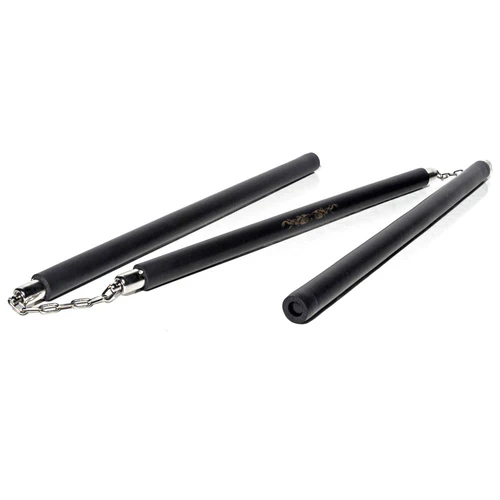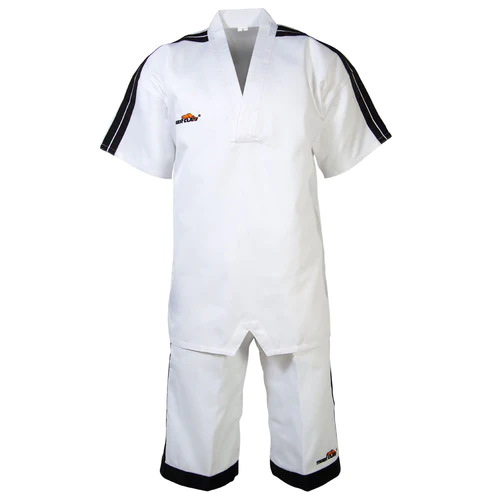 Kungfu tournaments can be overwhelming affairs. Due to our enormous diversity of styles, we are inundated with an overabundance of divisions. What's more, no matter how overflowing the arena is already, someone always comes up with yet another new event. Just before the deluge drowns our sensibilities, something surfaces that is really interesting. Deep within the People's Republic of China, some strange new events have arisen, well worth taking a closer look. Forget compulsory wushu, san shou or whatever you have seen before. Enter the weird world of kungfu - China's first water lei tai and qigong feat competition.
Kungfu tournaments can be overwhelming affairs. Due to our enormous diversity of styles, we are inundated with an overabundance of divisions. What's more, no matter how overflowing the arena is already, someone always comes up with yet another new event. Just before the deluge drowns our sensibilities, something surfaces that is really interesting. Deep within the People's Republic of China, some strange new events have arisen, well worth taking a closer look. Forget compulsory wushu, san shou or whatever you have seen before. Enter the weird world of kungfu - China's first water lei tai and qigong feat competition.
The Water is Wide
In 1999, the city of Taizhou in Zhejiang Province invited the world to a bizarre competition. Zhejiang is one of China's smallest provinces, but don't let its size fool you. Although unknown to most Western practitioners, it possesses a strong martial heritage. Situated on the coast of China, Zhejiang has been a major port of trade for centuries, one of the places Marco Polo visited. The influx of different cultures fostered a deep-rooted warrior tradition. Zhejiang was birthplace of Chan San Feng (Zhang Sanfeng,) the legendary founder of Taijiquan. It is also the resting place of one of kungfu's greatest heroes, General Yue Fei, the founder of Eagle Claw, Fanzi quan and Yuejia quan.
 One of Zhejiang's major ports is Taizhou. The ancient poet Tu Fu once praised Taizhou in a poem that went, "Taizhou is a vast place surrounded by sea, the water is wide and the land is green." It was here that 24 countries and 28 Chinese national teams, over a thousand competitors in all, gathered to test their skills against each other in the first "On Water Contest of the 'Liqun Cup' International Traditional Wushu and Unique Feats Tournament."
One of Zhejiang's major ports is Taizhou. The ancient poet Tu Fu once praised Taizhou in a poem that went, "Taizhou is a vast place surrounded by sea, the water is wide and the land is green." It was here that 24 countries and 28 Chinese national teams, over a thousand competitors in all, gathered to test their skills against each other in the first "On Water Contest of the 'Liqun Cup' International Traditional Wushu and Unique Feats Tournament."
Organized under the auspices of the Chinese Wushu Institute and the China Physical Division for Wushu, this groundbreaking tournament was held from May 22nd to the 26th. Like any Chinese tournament, it featured the two standard wushu events of taolu (forms) and sanda (free sparring,) plus an event just for Mulan quan. Mulan quan is based on the heroine Hua Mulan, the subject of the recent Disney movie. While still an obscure practice in the West, Mulan quan is a very popular amongst women in China, fusing fan dancing and martial arts into a health-promoting art form. But it was the two new events that were the most interesting - Water Lei Tai and Qigong Feats.
Water Lei Tai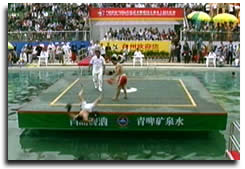 A Lei Tai is an elevated stage or platform for fight matches. The term "Lei tai" is also another nickname for free sparring matches. The Chinese character for "lei" combines the word for "thunder" with the radical for "hand." It can mean, "to give an open challenge." "Tai" means "stage" or "platform." The Lei Tai is the traditional kungfu-fighting arena. In days of old, an elevated stage was erected for public challenges so that all could witness the fight. It also offered fighters an "out" if they were losing. Since bouts were fought to satisfaction without safety gear, this type of fighting was very dangerous. Fighters could be permanently injured or killed. In fact, the practice was banned following the Republic of China because too many people were dying. But atop a Lei Tai, when a fighter was confronted with a more powerful opponent, he or she could always escape severe injury by jumping off the stage. You may lose face, but you won't lose your life. Despite this "out," the Lei Tai still claimed the lives of many fighters.
A Lei Tai is an elevated stage or platform for fight matches. The term "Lei tai" is also another nickname for free sparring matches. The Chinese character for "lei" combines the word for "thunder" with the radical for "hand." It can mean, "to give an open challenge." "Tai" means "stage" or "platform." The Lei Tai is the traditional kungfu-fighting arena. In days of old, an elevated stage was erected for public challenges so that all could witness the fight. It also offered fighters an "out" if they were losing. Since bouts were fought to satisfaction without safety gear, this type of fighting was very dangerous. Fighters could be permanently injured or killed. In fact, the practice was banned following the Republic of China because too many people were dying. But atop a Lei Tai, when a fighter was confronted with a more powerful opponent, he or she could always escape severe injury by jumping off the stage. You may lose face, but you won't lose your life. Despite this "out," the Lei Tai still claimed the lives of many fighters.
Today, the Lei Tai presents a one-of-a-kind arena, different than the more typical ring or cage match. Its architecture does not allow you to trap an opponent in the turnbuckle, so your fighting strategy shifts away from power boxing to more evasive maneuvers. Nor can you just charge someone, like the old "bum rush." A quick redirection will send you flying off the stage. And falling off can hurt, so fighters must deal with an added psychological factor when they approach the edge. Like Japanese Sumo, you have to stand your ground. Falling out-of-bounds constitutes a loss.
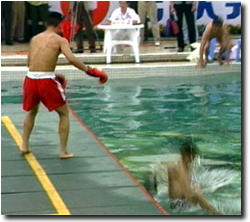 Typically, the area around the stage is padded to protect the fighters from falling injuries, but this time was different. For the first time ever, the Lei Tai was set in the middle of an outdoor pool. The defeated were dunked. To heighten the excitement, it was also meter shorter than a standard Lei Tai. Assistants were ready to jump into the pool and rescue any fighter, just in case someone was knocked out as they took the plunge.
Typically, the area around the stage is padded to protect the fighters from falling injuries, but this time was different. For the first time ever, the Lei Tai was set in the middle of an outdoor pool. The defeated were dunked. To heighten the excitement, it was also meter shorter than a standard Lei Tai. Assistants were ready to jump into the pool and rescue any fighter, just in case someone was knocked out as they took the plunge.
The Water Lei Tai was held on the afternoon of May 23rd. There were five divisions and it was the most attended event of the tournament. To add to the fighter's burden, it rained just before the fights, so the Lei Tai was extra slippery. Also fighters were restricted to minimal safety equipment, only gloves and shorts. This made the event bloody. The element of water added fire to the fights. The competitors rose to the occasion, delivering lots of high-impact action.
The Five Categories of Qigong
But despite this excitement, the most interesting event was the special feats or jueji. Jueji means unique or consummate skill. This is the realm of qigong performance stunts, like breaking boards, bricks and steel bars. But that's not all. In fact, that's just the beginning. Many masters practice a special skill, something they alone can master. Generally Western martial artists focus only on breaking, what the Chinese might call "iron hand." However, in kungfu, all parts of the body can be made "iron," such as iron head, iron shirt, iron leg, even the notorious iron crotch. But still, these iron skills represent only a small portion of the world of special qigong feats, of which iron hand is considered as the most basic. In fact, all competitors had to demonstrate iron hand just to enter this tournament. Beyond iron skills, there are other qigong demonstrations, like balancing belly-first on a trident point or a two-finger handstand, which don't involve any breaking at all.
Iron skills fall under the realm of martial qigong or "hard" qigong. There are many other categories. According to Beijing, almost 400 different kinds of qigong have been published, which does not account for the multitudes of folk practices and variations that are still unrecorded. Furthermore, qigong claims a 3000-year history, with early archeological evidence recorded on Zhou Dynasty (1100-771BCE) three-legged vases. Over the vast span of time, many original methods had undergone significant evolution, so much so that two schools might bear the same origin and moniker, but be totally different. This does not necessarily invalidate either one. The fact that any given variation has endured generations of practice is in itself a testament to its validity. Just as in kungfu (and by strictest definition, qigong falls under the heading of kungfu) this diversity creates an overabundance of divisions.
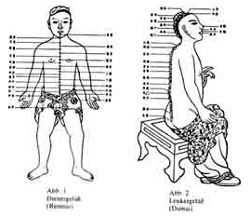 Generally speaking, there are five major categories of qigong practice. Those five are Longevity, Therapeutic, Spiritual, Projecting and Martial. These categories are not exclusive (in fact, there is a great deal of overlap) but they can serve for the sake of organization. Furthermore, qigong may be divided into static and dynamic. Static qigong has the outward appearance of stillness, while dynamic involves external callisthenic motion. Static qigong is usually limited to the "soft" or non-martial qigong. Distinguishing between these categories provides a much deeper understanding of the power of qi and its countless variations.
Generally speaking, there are five major categories of qigong practice. Those five are Longevity, Therapeutic, Spiritual, Projecting and Martial. These categories are not exclusive (in fact, there is a great deal of overlap) but they can serve for the sake of organization. Furthermore, qigong may be divided into static and dynamic. Static qigong has the outward appearance of stillness, while dynamic involves external callisthenic motion. Static qigong is usually limited to the "soft" or non-martial qigong. Distinguishing between these categories provides a much deeper understanding of the power of qi and its countless variations.
Longevity qigong (a.k.a. health qigong) are basic health exercises and the core concept behind of all the other categories. Although these often appear to be the most simplistic practices, they are in fact the most important. These methods teach you to identify your qi and circulate it throughout your body in a healthy manner. Without this basic understanding, channeling your qi to perform greater tasks is simply out of the question. Generally, Longevity qigong involves coordinating your breathing with some soft body movements and some visualization. From this foundation, the other four categories diverge. A few common longevity qigong styles are eight-section brocade (baduanjin), wild goose (dayan), and Shaolin muscle tendon transformation (yijinjing.)
Therapeutic qigong is used to combat illness and disease. It is implemented after longevity qigong has failed. Disease, from the viewpoint of Traditional Chinese Medicine and Qigong, is caused by the improper flow of qi. Usually, a qigong master will prescribe specific exercises to a patient to fight a particular ailment. Sometimes a strict regimen of longevity qigong is undertaken, often with an emphasis upon those sections that invigorate the afflicted area with qi and remove toxins. Lately, Western medicine has focused on these methods to cope with many difficult diseases, such as cancer and AIDS. Unfortunately, Western medicine tends to overlook the primary practice of longevity qigong. The anatomical application of this holistic practice works against the overall process of qigong. And yet, it still gets some results, so it continues to advance into Western medicine.
Spiritual qigong is used for self-cultivation and is often linked with a religious practice such as Buddhism and Taoism. It is meditation. Qi exists in all things vital. In fact, it is vitality incarnate. In spiritual qigong, you harmonize your qi with the ultimate vitality, the cosmos. The controversial Falun gong (Buddhist wheel) is a manifestation of a religious qigong, but it is atypical. Shaolin muscle tendon transformation could be considered a spiritual qigong, due to its Buddhist roots, but plenty of non-Buddhists practice it.
 The word "spiritual" is closely tied to the notion of qigong. "Qi" literally means "breath," so qigong is occasionally translated as "breath work." This descends from the belief that vitality resides within the breath. Without breath, there is no life. To attend to your breath brings your awareness directly into the present moment. However, even inanimate objects that are imbued with vitality can have qi, like a great painting or sculpture, so qi has a much higher meaning than just respiration. Note the "spir" root word in both "spiritual" and "respiration." Western ancients also believed that vitality resided in the breath. It is from this universal idea that we get the words "inspiration" (breathe in) "expiration" (breathe out) and "conspiracy" (breathe with.) While the word "Qi" is difficult to translate for Western scientists, it is not beyond the Western historic paradigm, evident in the roots of English. Those roots tap the same source, the notion of breath as life, so its fruit has an analogous flavor.
The word "spiritual" is closely tied to the notion of qigong. "Qi" literally means "breath," so qigong is occasionally translated as "breath work." This descends from the belief that vitality resides within the breath. Without breath, there is no life. To attend to your breath brings your awareness directly into the present moment. However, even inanimate objects that are imbued with vitality can have qi, like a great painting or sculpture, so qi has a much higher meaning than just respiration. Note the "spir" root word in both "spiritual" and "respiration." Western ancients also believed that vitality resided in the breath. It is from this universal idea that we get the words "inspiration" (breathe in) "expiration" (breathe out) and "conspiracy" (breathe with.) While the word "Qi" is difficult to translate for Western scientists, it is not beyond the Western historic paradigm, evident in the roots of English. Those roots tap the same source, the notion of breath as life, so its fruit has an analogous flavor.
The last two qigong categories are typically the only ones that can be demonstrated as feats (although Falun gong activists hold demonstrations, but not the kind that might be called a "feat.") Sometimes these two are underpinned with spirituality because both step outside the realm of our preconceptions of what is humanly possibility. Projecting qigong is most akin to psychic powers like telekinesis, levitation and faith healing. This is the most unexplained field, the most supernatural. Here, through arcane and shamanistic disciplines, you actually train to project your qi from your body to affect your physical environment. Here, Qi is like "the force" in Star Wars. This is the magic.
 Martial qigong has fighting applications. Masters train to deliver and withstand the hardest of blows by channeling their qi to the point of impact. These are the superhuman feats - iron hand, iron shirt, one-finger chan, basically anything you can use in a fight. Martial qigong training is logical step-by-step process based on the fundamental philosophy of good kungfu. Start by doing something simple and slowly build up. Practice regularly, everyday. In iron hand, for example, training starts by striking beans, usually mung beans. Slowly, the practitioner works up to harder substances, such as sand then metal shot. This external training is complimented by a regimen of internal qigong exercises and massage with special healing herbal liniments. The exact process varies from school to school, but the fundamental method is universal. However, although this process may seem simple, it is not something that should be attempted without the supervision of a qualified master. Beginners to martial qigong can easily overdo and cause themselves injury. Don't try this at home alone.
Martial qigong has fighting applications. Masters train to deliver and withstand the hardest of blows by channeling their qi to the point of impact. These are the superhuman feats - iron hand, iron shirt, one-finger chan, basically anything you can use in a fight. Martial qigong training is logical step-by-step process based on the fundamental philosophy of good kungfu. Start by doing something simple and slowly build up. Practice regularly, everyday. In iron hand, for example, training starts by striking beans, usually mung beans. Slowly, the practitioner works up to harder substances, such as sand then metal shot. This external training is complimented by a regimen of internal qigong exercises and massage with special healing herbal liniments. The exact process varies from school to school, but the fundamental method is universal. However, although this process may seem simple, it is not something that should be attempted without the supervision of a qualified master. Beginners to martial qigong can easily overdo and cause themselves injury. Don't try this at home alone.
Special Qigong Feats
Like many kungfu in days of old, qigong feats were often performed for entertainment. Martial artists traveled alongside acrobats in street performances and circus acts, not unlike the strong man in the Western carnival. Consequently, there is a huge grey area between a qigong performance and a carnival stunt. For example, sword swallowing is considered by some to be a qigong feat. Just like the mystic fakirs of India, these types of feats push the envelope of our understanding of human potential, an uncharted territory, shrouded in fantasy. It eludes scientific analysis.
This is the first time that a competition of qigong feats has been attempted. It is common sense to be skeptical. The attitude of the promoters was made clear. Although many believe that qigong feats are superstitious and unscientific, more like a magician performing some kind of trick, and there certainly remains a fair share of fraud in such performances, the fact that some masters possess real kungfu is undeniable. The Vice President of China's National Physical Bureau Wushu Management Center, Mr. Wang Guoqi commented, "Special feats in wushu practice can be used for self defense. What we really have to do now is to try and tell the false from the true, just like picking out gold from the sand. We did everything we could to guarantee the truth of this competition. We supplied all equipment, including the bricks, all baked at one factory. If the performers brought their own equipment, they had to submit it for inspection beforehand, then it was sealed until the competition began. From the start, this competition was controversial. People think qigong is fake. Some thought it was useless for your health so it shouldn't be developed. Others worry that kids would imitate it and get hurt. But we all want to see if some special skills are really buried here. Even though there were so many opinions, when we announced the competition, every event was crowded with people. This is the first step of a difficult road."
The second compulsory was more unusual - throwing a needle through glass. Needle throwing is practiced in Mainland China as a method of self-defense. The "needles" are bigger than sewing needles, but smaller than an average nail. According to hearsay, some masters get so proficient that they can throw a needle through an aquarium full of water and make it penetrate both panes of glass and the water. This is a high-level skill. Only a few competitors actually pierced the glass. But imagine the power. Notably, a successful needle-throwing master wore a special military uniform. It arouses visions of some James Bond-like Special Forces assassin.
After participating in both compulsories, competitors had their choice of any feat of hard, soft or light qigong. Classic feats, such as bending iron bars around the arm or bouncing a giant log battering ram off the belly, were juxtaposed with some new ones like balancing on top of a rifle bayonet. One-finger push-ups and two-finger handstands were demonstrated, along with snapping metal wire with bare fingertips (this by Grandmaster Alexander Tao, see Jan/Feb 2001 cover story.) Interspersed among the traditional kungfu silk uniforms were a great number of military fatigues. Within Mainland China, the military and police are some of the most hardcore kungfu practitioners, so they came out in force to this unprecedented event.
Of course, breaking was the most prevalent, but even these demonstrations were taken to a higher level. Never mind the spacers, competitors were breaking bricks and steel bars that were free standing. This takes the highest level of skill, since if the focus is not exact, the object will just fall over instead of breaking. In one of the most impressed demonstrations, Master Xie Fayu from Anhui Province broke 100 bricks in rapid succession over his head, one at a time. It was an astounding demonstration of concentration and stamina. Bricks were flying everywhere and the hall was filled with a resounding crack of skull against masonry. By the end, the entire audience was cheering and counting 97! 98! 99! 100!! Boards, bricks and metal bars, nothing was safe from these qigong masters.
However, this tournament was not without injury. A few of the competitors suffered cuts and bruises, but none serious. Like the water Lei Tai, there were some bloody moments. Most likely, this will prevent such a tournament from being held on American soils. Mainland China does not hold the same regard for liability insurance as the United States. An event like qigong feats would be next to impossible to insure here. So, if you want to see this kind of competition live, you need to go to Zhejiang. This was the first such tournament ever held, so Taizhou has yet to established a regular schedule. However, given the success of this event, it is likely that they will attempt it again.
Until then, TC Media has acquired footage of this historic event. Titled "eXtreme Kungfu Qigong"this video brings you all the action straight from Taizhou. It will be available through our product fulfillment center, www.MartialArtsMart.com. Remember don't try this at home!
About
Gene Ching :
![]() Gene Ching is the Assistant Publisher of Kungfu Qigong Magazine & KungfuMagazine.com
Gene Ching is the Assistant Publisher of Kungfu Qigong Magazine & KungfuMagazine.com
![]() Print Friendly Version of This Article
Print Friendly Version of This Article










